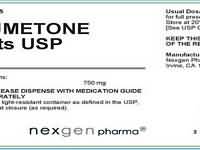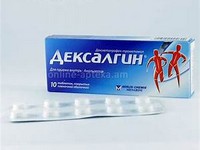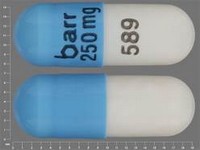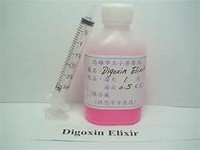nabumetone

CLINICAL USE
NSAID and analgesic
DOSE IN NORMAL RENAL FUNCTION
1 g at night; in severe conditions 0.5–1 g in the morning as well; elderly 0.5–1 g daily
PHARMACOKINETICS
Molecular weight :228.3 %Protein binding :>99 %Excreted unchanged in urine : <1 Volume of distribution (L/kg) :0.11half-life – normal/ESRD (hrs) :24/391 DOSE IN RENAL IMPAIRMENT
GFR (mL/MIN)
20 to 50 : Dose as in normal renal function, but avoid if possible 10 to 20 : 0.5–1 g daily, but avoid if possible <10 : 0.5–1 g daily, but only use if on dialysis. See ‘Other Information’ DOSE IN PATIENTS UNDERGOING RENAL REPLACEMENT THERAPIES
CAPD :Not dialysed. Dose as in GFR <10 mL/min HD :Not dialysed. Dose as in GFR <10 mL/min HDF/high flux :Not dialysed. Dose as in GFR <10 mL/minCAV/VVHD :Not dialysed. Dose as in GFR=10–20 mL/min IMPORTANT DRUG INTERACTIONS
Potentially hazardous interactions with other drugsACE inhibitors and angiotensin-II antagonists: antagonism of hypotensive effect; increased risk of nephrotoxicity and hyperkalaemiaAnalgesics: avoid concomitant use of 2 or more NSAIDs, including aspirin (increased side effects); avoid with ketorolac (increased risk of side effects and haemorrhage)Antibacterials: possibly increased risk of convulsions with quinolonesAnticoagulants: effects of coumarins enhanced; possibly increased risk of bleeding with heparins and coumarinsAntidepressants: increased risk of bleeding with SSRIs and venlafaxineAntidiabetic agents: effects of sulphonylureas enhancedAnti-epileptics: possibly increased phenytoin concentrationAntivirals: increased risk of haematological toxicity with zidovudine; concentration possibly increased by ritonavirCiclosporin: may potentiate nephrotoxicity Cytotoxic agents: reduced excretion of methotrexate; increased risk of bleeding with erlotinib Diuretics: increased risk of nephrotoxicity; antagonism of diuretic effect; hyperkalaemia with potassium-sparing diuretics Lithium: excretion decreased Pentoxifylline: increased risk of bleeding Tacrolimus: increased risk of nephrotoxicity ADMINISTRATION
Reconstition
– Route
Oral Rate of Administration
–Comments
– OTHER INFORMATION
Nabumetone is absorbed from the GI tract and rapidly metabolised in the liver to the principal active metabolite 6-methoxy-2-naphthylacetic acid (6-MNA). The metabolite is a potent inhibitor of prostaglandin synthesis. Excretion of the metabolite is predominantly in the urine. The SPC recommends a dose reduction if creatinine clearance <30 mL/minute
See how to identify renal failure stages according to GFR calculation
See how to diagnose irreversible renal disease
Home









